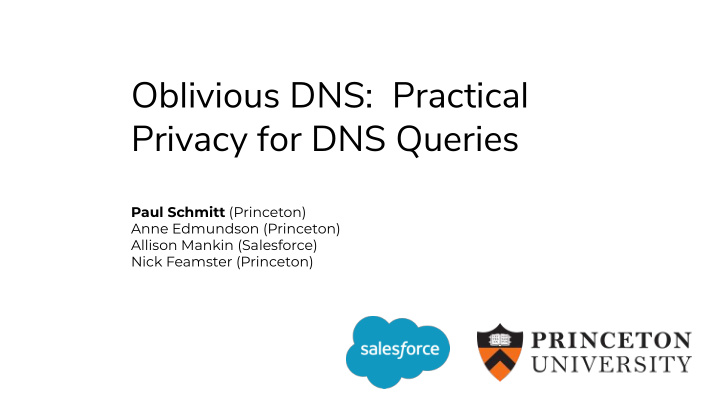



Oblivious DNS: Practical Privacy for DNS Queries Paul Schmitt (Princeton) Anne Edmundson (Princeton) Allison Mankin (Salesforce) Nick Feamster (Princeton)
Conventional DNS 2 Root Server www.foo.com? 3 1 TLD Server Client Recursive DNS Server 4 Authoritative Server
Conventional DNS www.google.com www.amazon.com Client identity and query ● www.bing.com are viewable at and prior to the recursive (ISP) 2 Root Server server 3 1 DNS operators can be ● targets of data requests TLD Server Client Recursive DNS 4 Server Authoritative Server
Conventional DNS www.google.com www.amazon.com Services now offer open ● www.bing.com DNS resolvers with promise of deleting logs 2 Root Server Shifts trust to these ● 3 1 providers TLD Server Client Recursive DNS 4 Other techniques do not ● Server fully protect user privacy: DNS-over-TLS ○ DNS-over-HTTPS ○ Authoritative QNAME minimization ○ Server
Oblivious DNS User queries NOT visible Goal: at recursive server Separate user identity Stub encrypts & formats ● domain with a session key from query 2 Root Server 1 3 Requirements: TLD Server Clients ODNS Stub Recursive 4 DNS Server Compatible with ● existing infrastructure ODNS Authoritative Server Minimize overhead ●
Oblivious DNS User queries NOT visible Goal: at recursive server Separate user identity Stub encrypts & formats ● domain with a session key from query Root Server 2 Root Server 5 1 3 Requirements: 6 TLD Server TLD Server Clients ODNS Stub Recursive 4 DNS Server Compatible with ● 7 existing infrastructure ODNS Authoritative Server Authoritative Server Minimize overhead ● ODNS authoritative acts as a recursive resolver User identities NOT visible at ODNS Authoritative server
ODNS Crypto Overhead ● Roughly ~1-2 ms for crypto operations using standard libraries ● Symmetric encryption/decryption is lightweight
ODNS Crypto Overhead ● Roughly ~1-2 ms for crypto operations using standard libraries ● Symmetric encryption/decryption is lightweight
ODNS WAN Latency ● Latency to ODNS Resolver added to each query ● Widespread anycast deployment to mitigate WAN latency
Key Distribution Anycast for scalability ● Special query reaches the ● nearest anycast server Server responds with ● public key and name
ODNS Overhead: Page Load Time
ODNS Overhead: Page Load Time Different CDNs / javascript resources
ODNS Overhead: Page Load Time How is ODNS better in some cases?
ODNS Overhead: Page TTFB
ODNS Overhead: Page TTFB Directed to CDNs that are closer
Impact on Recursive Cache ● Simulated with trace of ~8M queries ● If caching at stub, ODNS reduces traffic burden on the recursive resolver
Impact on Cache (2) ● Undesirable cache entries? ● Some resolvers ignore TTL = zero ● “Bad” == ODNS entry causing non-ODNS to be ejected
Discussion ● Challenges: ○ EDNS0 Client Subnet ○ QNAME length ○ 0x20 bit encoding ● Policy-based routing
Thank you Paul Schmitt pschmitt@cs.princeton.edu
Backup slides
Why Not Tor? ● Latency (median) ○ ODNS: 31.31 ms ○ Tor: 276.76 ms ● Censorship concerns ● Exit node can be associated with traffic
Protocol Stub encrypts query with ● session key and session key with resolver public key Stub appends resolver ● name to encrypted query ODNS resolver decrypts ● session key with private key, query with session key, and encrypts response
QNAME Length ● QNAME = 4 sets of 63 bytes ● base64 encoding ○ 0x20 bit encoding issue
EDNS0 Client Subnet ● Must avoid some recursive resolvers
Recommend
More recommend